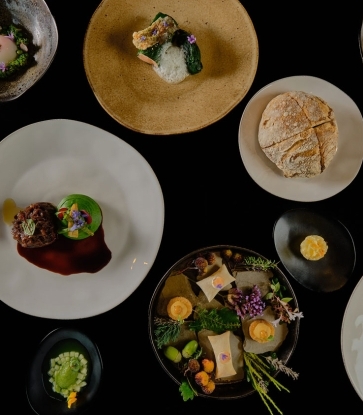The world is indebted to France for its gifts of great fashion and food—the little black dress and shallots, the little black dress of cooking. Long a staple in French kitchens (hat tip to Escoffier), credit is given to Julia Child’s Mastering the Art of French Cooking, Volume 1 for introducing American home cooks to this alluring allium. Our sauces, vinaigrettes and any shallot-blessed dishes have never been better.
Though the French receive credit for introducing shallots to the rest of us, food historians believe the first shallots were likely found in Central or Southeast Asia before making their way to India and the Mediterranean through trade and travel. Shallots are mentioned in Greek history and ancient Egyptians put shallots to use medicinally due to their antifungal and antibacterial qualities.
Shallots are botanically classified as alliums, making them part of the onion family. And no, they are not baby onions, as they’re often incorrectly called. Like onions, shallots are covered in a thin, brown, papery skin that should be removed before use. Their shape is uniquely shallot, an elongated bulb that narrows at each end. Beneath the skin, shallots are similar to garlic, consisting of several multilayered cloves that are flat on one side and round on the other.
Shallots are lighter on the palate than onions and have a distinct taste that marries the flavors of both onions and garlic. They are an excellent aromatic, often added early in the cooking process to build flavor. Shallots add depth of flavor to sauces, liven up vinaigrettes and are downright creamy when roasted. Keep in mind that shallots are not as hearty as onions—they won’t hold their shape as well if cooked at high temperatures for a long period of time.
The French red shallot is what you’re most likely to find in your grocer’s produce section, but there are other varieties. Banana shallots are the largest shallot variety, but despite their size they are the mildest in flavor. The French gray shallot, a difficult find in American markets, is regarded as the finest and best tasting of all the shallots. It boasts a robust flavor, with a large pear-like bulb and a grayish-blue skin that is thicker than other varieties. Dutch shallots are smaller with an orangish or yellow skin and a more pronounced onion flavor.
Choose shallots that are smooth, unbruised and blemish-free. They should be firm and dense. Steer clear of shallots that feel too light and don’t have a little weight to them—those are likely old and have dried up inside.
Unlike many other vegetables, which benefit from refrigeration, shallots fare best in a cool, dark, dry space, like a pantry or a drawer. Refrigeration can affect shallots’ texture, making them soft and spongy instead of firm and crisp. Shallots should never be stored in plastic bags because the lack of air can cause them to spoil faster. Lastly, be sure to avoid storing shallots or onions near or with potatoes since gasses emitted by both will lead to speedier spoilage of each other.
Though not typically considered a health food, there are numerous health benefits associated with eating shallots. They’re high in potassium, which can help lower blood pressure, and Vitamin A, a nutrient that supports improved eye health. Shallots are also rich in fiber, which aids in digestion, and they can boost circulation due to their high copper and iron content. The numerous antioxidants present in shallots are also an excellent defense against harmful free radicals that can lead to serious medical conditions.
Shallots have long been a staple in professional kitchens and chefs continue to highlight the beloved allium. The wood oven-roasted whole fish at Blue Duck Tavern in Washington, D.C., is accompanied by an herb salad with crispy shallots. Diners at D.C.’s MICHELIN-starred Masseria can savor chef Nicholas Stefanelli's piccione, which features squab with blackberries, porcini, and shallots. Elsewhere across the country, a sherry shallot vinaigrette adorns the house salad at The Promontory in Chicago, and at New York City’s Tiny’s, a seared duck breast is served with a plum agridolce, roasted turnips and shallots.
Shallots can be something of a mystery at first glance, but the magic beneath the parchment-like skin is worth investigating. Shallots should be a staple ingredient in every kitchen.

What Is The MICHELIN Bib Gourmand Award?
Since 1997, The MICHELIN Guide’s Bib Gourmand has celebrated restaurants worldwide that serve exceptional food at great value— here’s what makes it special.

What is a MICHELIN Star?
The MICHELIN Guide explained — criteria for Stars; One Star versus Two Stars versus Three Stars; how service and decor factor in; and more. All your questions answered by our MICHELIN Guide Inspectors.

From Stalls to Stars: Street Food’s Mark on Asia’s Cuisine
MICHELIN-Starred restaurant chefs from Bangkok, Hong Kong, Kuala Lumpur, Penang and Singapore share how street food continues to define Asia’s dining identity.

















